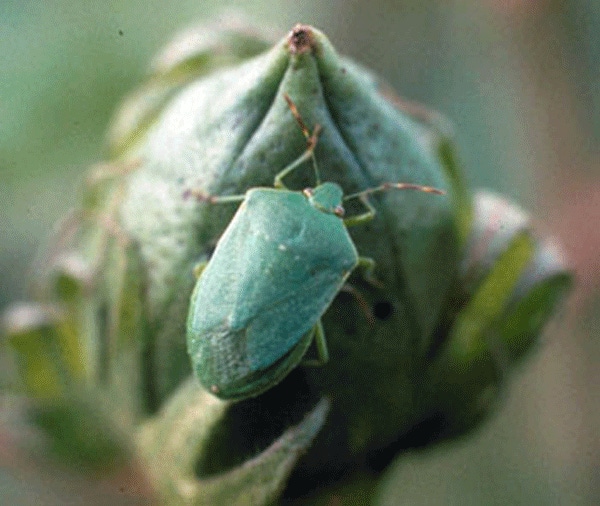
Southeast states join forces in stink bug control effort
• Today, virtually all North Carolina cotton is genetically engineered with the bacterium Bacillus thuringiensis to control caterpillars.• As caterpillars have declined, so has the need to apply insecticides — but with the drop in spraying has come a rise in stink bugs and other insects that aren’t susceptible to Bt.
May 25, 2011

Working on Bertie County land their family has farmed for generations, cousins B.B. and John Griffin know a thing or two about growing cotton.
But, they say, when it comes to staying a step ahead of pests, diseases and other production challenges, they’ve come to rely on their Cooperative Extension agents and specialists for timely solutions.
To explain what they mean, the Griffins cite stink bugs, which have in recent years emerged as one of the most economically important cotton pests.
Today, virtually all North Carolina cotton is genetically engineered with the bacterium Bacillus thuringiensis to control caterpillars. As caterpillars have declined, so has the need to apply insecticides — but with the drop in spraying has come a rise in stink bugs and other insects that aren’t susceptible to Bt.
B.B. Griffin notes that when stink bug problems began to emerge, scouts that growers hired to detect and deal with pest problems made inconsistent recommendations. No one, he says, knew when to spray to achieve the best level of control at the least cost and with the least environmental risk.
“Our scout might have us spraying, while somebody else with a different scout on land adjoining our field would say we are crazy to be spraying,” he says. “The growers didn’t know what to do.”
Large-scale effort
To come up with answers farmers and consultants could depend on, agricultural scientists from land-grant universities in the Carolinas, Virginia, Georgia and Alabama began working together to conduct research and develop management guidelines. They found that stink bugs are most likely to cause economic yield losses only during a relatively narrow window during the growing season — the third through fifth week after cotton plants bloom.
North Carolina State University scientists developed a stink bug decision aid card to help farmers figure out when they need to spray for stink bugs.
At North Carolina State University, entomology specialist Jack Bacheler and technician Dan Mott developed a tough plastic field card that growers and crop scouts can use to figure out whether to spray. It illustrates how the boll damage threshold changes according to week of bloom.
The card has pictures illustrating the type of damage stink bugs do and explains the use of the new “dynamic,” or changing, threshold. It also includes holes that growers and scouts can use to more accurately gauge the size of vulnerable bolls on which the new threshold is based.
Bacheler estimates conservatively that at least 20 percent of North Carolina cotton growers now use the cards, potentially saving themselves a total of $8 million a year by limiting yield loss and eliminating unnecessary sprays. These cards are being evaluated throughout the remainder of the Cotton Belt in 2011.
As B.B. puts it, “You don’t want to spray when you don’t have to. And you certainly need to spray when you need to. Now, thanks to scientists working together across state lines, we have a way of knowing when it’s the right decision.”
It’s just one example, John Griffin adds, of the many ways that Extension helps farmers get timely answers to problems that can threaten their livelihood.
“Some people say that the large farmers are beyond Extension. But that’s not true,” John says. “We need them as much or more than anyone else, and we need them as much now as we ever have. A lot of things pop up in agriculture. You never know what’s next. And in some circumstances, time is critical. You could lose your crop if you aren’t able to get reliable answers.”
You May Also Like



